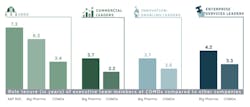Strengthening CDMO leadership
Contract development and manufacturing organizations (CDMOs) are now a vital part of the pharmaceutical value chain, with the current market landscape unimaginable without them. Initially offering a value proposition as vendors and contractors, today’s CDMOs are full-fledged strategic business allies with their pharma counterparts, solidifying their position as trusted advisors, reliable partners, and subject matter experts.
Rising manufacturing standards, cutting-edge novel therapeutics, and growing demand for personalized medicine spurred on this evolution, with two distinct new strategic approaches emerging: larger CDMOs are moving towards vertical integration, becoming end-to-end service providers, while smaller CDMOs are leaning into niche and complex specialisms in manufacturing and development. Both approaches require in-depth expertise, flexibility in approach, and sustained responsiveness to client and market forces.
Confronting the leadership turnover trend
Proprietary research conducted by WittKieffer on the composition and background of executive teams at 18 leading CDMOs revealed that the average leadership tenure within CDMOs is strikingly below the average in big pharma, and significantly lower than that for S&P 500 companies (Figure 1). The CEO turnover rate is particularly notable: CEOs at CDMOs have an average tenure of roughly half of that seen in S&P 500 chief executives. Five of the 18 companies in our sample had CEO changes in the previous 12 months, highlighting the fast-paced nature of the industry, along with its stringent demands for consistent and significant results.
Commercial leaders (referring to geographic or business unit heads) in our sample have a current average tenure of just 2.2 years, while innovation-enabling leaders (whose functions include R&D, technical operations, business development, and strategy) have a current average of 2.6 years. Incumbent enterprise services leaders (functional roles such as HR, legal, and finance) average a 3.3-year tenure — demonstrating that, notably, all of these subsets are below their pharma industry counterparts’ tenures.
Short turnover times do afford CDMOs the opportunity to constantly reinfuse a leadership team with fresh skills, competencies, and expertise, and may allow them to respond more quickly to business needs with leadership exhibiting certain competencies or bringing a particular skill or industry background required at any given time.
On the other hand, frequent leadership changes can result in significant challenges for all roles, with the potential to disrupt organizational momentum, impact employee morale, and pose challenges in maintaining long-term strategic consistency. This notable flux underscores the competitive nature of the industry and requires agility and adaptability from executives at all levels.
Prioritizing talent-to-value
The complexities of CDMOs, operating in a B2B model, are different from those of pharma companies, as they must manage technological advancements, diverse portfolios, manufacturing footprints, strategic resource allocation and budgeting, and increasingly sophisticated processes. CDMOs must also address individualized requirements related to technology, confidentiality, and regulatory compliance for their diverse pharma and biotech clients in the context of shorter planning horizons, requiring them to be highly adaptable and responsive to changing client needs and market dynamics.
As the organizations matured to meet client needs, so too in turn did the leadership requirements of CDMOs evolve. Today’s successful CDMO executives exhibit the following leadership competencies:
- Adaptability and flexibility to thrive in a fast-paced, innovative environment;
- Exceptional customer service/focus and interpersonal skills;
- Organized approach and results-oriented mindset, with the ability to work effectively under pressure to meet deadlines;
- Ability to communicate complex value propositions in a concise, coherent, and professional manner;
- Strong networking skills to effectively liaise with diverse stakeholders, including clients/partners, regulators, and internal teams;
- Experience in negotiating difficult issues in a well-thought-out and professional manner; and
- A collaborative mindset to foster partnerships and drive innovation within the ecosystem.
Dealing with the complexity and current high turnover rates outlined above requires CDMOs to take a clear and focused approach to their leadership strategy, with an aim to maintain and enhance their competitive edge in this rapidly evolving market. We recommend CDMOs to consider the following guidelines:
- Proactively enhance core leadership capabilities: Business needs and their corresponding leadership competency requirements should be regularly analyzed and revised, providing CDMOs with a clear roadmap for the leadership capabilities they need to prioritize acquiring externally or developing internally.
- Prioritize diversity to make better teams: Building diverse executive teams that promote gender parity and incorporate a wide range of backgrounds and perspectives is critical for driving innovation and success in the CDMO space.
- Adapt expertise: CDMOs must embrace the shifts in the industry value proposition by bringing in subject matter experts who can guide the companies through ongoing business transformation – such as experts in new processes/technologies they are offering, specialists in specific emerging therapies or treatments, and leaders in AI and digital transformation.
- Foster a sense of purpose: Addressing high executive turnover rates prevalent in the industry necessitates emphasizing a sense of purpose within the company, aligned on clear goals, values, and behaviors.
- Build a strong internal talent bench: Investing in leadership development and succession planning allows CDMOs to develop a robust internal talent pipeline, laying strong foundations for the future and allowing skills and competency gaps to be identified early.
- Accelerate strategy execution through active change management: Alongside building their robust talent bench internally, CDMOs should proactively develop organizational culture that accelerate strategy execution through active change management, through a structured and strategic approach.
- Utilize interim and on-demand talent: In times of transition and transformation, flexible access to the right expertise at the right time is essential. Interim and on-demand leaders can provide necessary expertise, speed, agility, and objectivity to help CDMOs navigate these critical periods successfully.
The talent strategies outlined above prioritize optimizing a talent-to-value approach, recognizing that talent is a powerful asset when properly aligned with business goals. Given the high rate of turnover endemic to today’s top CDMOs, we believe there is a sector-wide need to better cultivate the leaders and leadership teams of today and tomorrow. By investing in their executives — as well as expanded organizational capabilities, better processes, and new technologies — CDMOs can position themselves for long-term success. This will allow them to be true collaborative, full-service partners to their pharma and biopharma clients and, by extension, contributors to the health and well-being of communities and society.
About the Author
Morten Nielsen
WittKieffer
A senior partner for the Life Sciences Practice at WittKieffer, Morten Nielsen (he/him) has more than three decades of direct, relevant industry experience. Most recently he has spent over 10 years in executive search, including various global leadership responsibilities. He has recruited board directors, CEOs, and other C-level executives across most functional areas inclusive of R&D, medical, clinical, commercial, operations, quality, and regulatory affairs for organizations in healthcare, medical device, diagnostic, pharmaceuticals, and biotech.
Prior to entering the executive search industry, Morten spent over 20 years working within the healthcare and life sciences industries. Approximately half of his industry career was spent in Europe. He began his career with Pharmacia Diagnostics (now GE), where he held Account Representative and Product Specialist roles. He also held roles in marketing with Baxter, general management roles with Rhone-Poulenc Rorer (now Sanofi), and Wyeth (now Pfizer) prior to moving into medical devices with Boston Scientific. His last role in the industry before moving into executive search was as Corporate Vice President and Group President, Life Sciences with STERIS Corporation.
Morten currently serves as Chair, Emeritus of the global board of directors of the Association of Executive Search and Leadership Consultants (AESC).
Mindy Steiger
WittKieffer
Mindy Steiger, a consultant in WittKieffer’s global Life Sciences Practice, has over 15 years’ experience in executive search. She is currently responsible for supporting the global Life Sciences team on assignments where she helps plan and execute senior-level searches from a sourcing perspective. Her experience in executive search includes business development, research strategy and operations, and sourcing. Mindy also supports WittKieffer’s Healthcare Practice with senior-level search assignments.
Based in Cleveland, Ohio, Mindy uses her broad understanding of industry trends and extensive network to identify difference-making, high-caliber senior executives and leaders in the pharmaceutical, biotech, CDMO, and medical device industries. She believes in exceptional client service and communication, and in treating candidates with courtesy and respect.
Prior to joining WittKieffer, Mindy worked as an associate with another top 10 global executive retained search firm for nearly 10 years, where she was a member of the CFO/Financial Officers and Private Equity Practices. She has served hundreds of clients in various sectors and sizes, from start-ups to global, publicly traded companies with multi-billion dollar revenues. Earlier in her career, Mindy worked as an account representative for SOLION, a division of medical practice management software company Medical Manager (WebMD), in Orlando, Florida.

